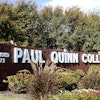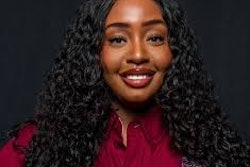Time was, when you mentioned HU and Black college football supremacy, you were talking about storied Howard University.
No more. Hampton University ascended to lofty heights this year,
claiming the Mid-Eastern Athletic Conference (MEAC) title in its first
year of eligibility while also grabbing a national ranking in NCAA
Division I-AA. It was the school’s second year of competition on that
level.
And while ninth-ranked Hampton proved to be the class of the MEAC,
the conference itself proved formidable with the ascendance of two
other schools. Florida A&M and South Carolina State Universities
were both ranked in the Top Twenty-five of Division I-AA. Additionally,
Jackson State University and Southern University, members of the
Southwestern Athletic Conference (SWAC), also had Division I-AA Top 25
rankings.
All of the schools enjoyed the prestige of being invited to
participate in postseason play. And for the first time in the Division
I-AA playoffs, two Black institutions were extended at-large bids.
Hampton earned an automatic bid because of its MEAC championship.
Florida A&M, ranked eleventh, and Jackson State, ranked fifteenth,
received the at-large bids.
Twelfth-ranked Southern, the SWAC champion, played in the Bayou
Classic against conference rival Grambling University. South Carolina
State, ranked No. 20, will play in the upcoming Heritage Classic
against Southern.
Despite playoff losses by Hampton, Florida A&M, and Jackson
State, the exposure bodes well for Black colleges and for their
conferences, MEAC and SWAC. Hampton, which moved up to the MEAC and
Division I-AA in football two years ago, wasn’t expected to be
competitive in its conference — let alone nationally — this soon.
A Ten-year “Overnight” Success
The seemingly overnight success was well calculated, according to
Dr. William R. Harvey, president of Hampton, who says the school began
planning the move to an upper division ten years ago.
According to Harvey. Hampton first brought in a consultant, the
athletics director at Arizona State University, “to assess where we
were and what might be needed to make the move. We had decided to do it
and do it right.”
Harvey says that with the support of the board and the
administration, We started while in Division II doing the things that
would help us when we moved to Division I.
That included building a new basketball arena, as well as a tennis center.
But new facilities have little to do with competitiveness, Harvey
says. He likes to remind people that Hampton had been very, competitive
in its old conference, the Central Intercollegiate Athletic
Association. where it won the conference all-sports trophy six of the
last seven years it was a member. The school has also won four national
team titles, including a national women’s basketball title.
“So winning is not new to Hampton,” Harvey says. “We didn’t just
wake up and decide to move to Division I…. We were all prepared for
the move.”
Dennis Thomas. Hampton’s athletics director, calls the preparation
for the move a “labor of love” that has paid off handsomely. But it
took a lot of planning, hard work, and commitment to be successful, he
says. noting that division changes are not without financial commitment
— including the addition of sports and scholarships to meet division
requirements.
“We didn’t want to be reclassified just to be in Division I.” he
says. “We wanted to be successful, we wanted to compete at the highest
level. We mapped out a strategy of things we needed to do in order to
get success and then maintain it.
“Our success did not catch us by surprise,” Thomas adds. “Success
like we have does not happen haphazardly. it is by design and with the
support of the administration, alumni, and community. Contrary to what
a lot of people think, you have to have more than players and coaches
to be a success.”
The new prominence in sports brings Hampton “greater visibility and
greater name recognition. Thomas says. “We now get into places we
wouldn’t be able to get into in Division II.”
He cites the Division II.” football classics the school has played
in and the financial windfall they bring. The higher division also
facilitates basketball games against national powers like Duke and
North Carolina, who see an appeal to playing a fellow division member.
“That was not going to happen in Division II,” Thomas says.
Charles Harris, the Arizona State athletics director who served as
the consultant for Hampton’s move to Division I, is now commissioner of
the MEAC. Obviously proud of the performance of all & teams in the
MEAC. Harris certainly was not shocked by Hampton’s surge to the top of
the conference,
“Hampton moved into Division I with the clear goal of being
competitive,” he says, “and at every level they primed for that and got
a return for the investments.”
Attracting Student Athletes
Overall, the conference is stronger, Harris says, with as many as
six of the nine football members ranked nationally at some time during
the season.
“There has been general improvement in the quality of play in the
league,” he says, citing strength of the schedule as the reason. The
three ranked MEAC schools played a Division I-AA schedule exclusively,
“so in the general scheme of things, that’s why they are ranked. It is
the quality of your competition. We’ve made great strides in football
and in basketball, and as we do, the quality of the play speaks for
itself.
And the exposure such prominence brings is invaluable for Black colleges, Harris says.
“As they move into postseason, they become legitimate institutions
for both athletics and academic reasons,” he says. “This [postseason
play] is going to attract a lot of kids for a lot of good reasons and
hopefully sustain our good fortunes.”
Willie Jeffries, head football coach at South Carolina State.
applauded Hampton’s success, saving he credited it to excellent
coaching combined with excellent recruiting. And he notes that several
other Black colleges are also basking in the glory of football
prominence.
MEAC football teams have improved so much in the past few years.”
Jeffries says. “There is parity in the MEAC because we’re getting
better coaches and better athletes.
According to Jeffries, part of the reason for their success is an increase in recruiting budgets,
“Players love to be recruited he says. “They love for you to come
and want them. That is a psychological thing among Black players. Black
kids may have been deprived a little bit, or disadvantaged, and they
love to be pursued. With us getting a little more money, and when we
present our graduation rates, a lot of parents lean towards us.”
While the Black colleges still have difficulty recruiting against
larger schools, “there are some families that realize the graduation
rate at a historically Black college is better than playing before
80,000 on a Saturday. That allows us to recruit and get better kids.”
Some detractors accuse the school of riding to football success on
the backs of better athletes who have been recruited from Division I-A
football schools, an accusation Harvey says is overblown.
“We are not ashamed of it, but it is only three guys. Three does
not make a football team. You need more than three guys to produce a
winner.”
Beneficial Coexistence
In fact, Harvey says it takes much more to produce a winner — at least at Hampton.
“This [success] is testimony to the coaching staff, young men and
supporters who make up the team,” he says. “We look at it as a team
approach, not one particular ingredient. We have a great athletics
director in Dr. Thomas, a great coach in Joe Taylor, and terrific young
men.
“We have a support staff that helps with football and athletics in
general and an administration that provides the wherewithal to do these
kinds of things — an enabler if you will.” Harvey continues. “The team
approach is not unlike what you do in physics; it’s a learning
situation and it takes organization and strategy to win.
“You have to have a healthy body and a clear mind. You do all this
and it will make you successful in football and basketball, but it will
also make you a success in life,” he adds. “That is why football is not
different from physics; it is about learning and learning is the raison
d’etre for a place like Hampton.”
But can athletics and academics coincide and thrive at Hampton and
other Black colleges? President Harvey names several colleges — like
Harvard, Duke, and Stanford — that enjoy excellent reputations in both
areas. He believes Black colleges can and should do the same.
“The trick is for the administration, the athletics administration,
and for coaches to understand that these young men and women are
student athletes, not athletes,” Harvey says. “Students come first. We
don’t give any slack, as some schools do, to people who run the
football.” He has to get his lessons first.
Defining Tests
A defining test came in Hampton’s first trip to the Division I-AA
playoffs, a competition where Black colleges have not fared well
despite Florida A&M winning the division’s first championship back
in 1978. Poor performances from Black colleges in the playoffs have
helped perpetuate a non-competitive label, according to James Frank,
commissioner of the SWAC.
“Just to make a general statement to say we are not competitive. I
don’t believe that.” Frank says. However, some of it is based on our
performance in postseason play. We’ve been beaten soundly in many
instances, and we have not done that great in nonconference play
either. We can he more competitive. . . . The test is in the playoffs
when you compete against the best in the country.
Hampton, Florida A&M, and Jackson State all were vanquished in
the first round of the Division I-AA playoffs. Hampton was bounced by
Youngstown State University, 28-13; Florida A&M was defeated by
Georgia Southern University, 52-37; and Jackson State was upended,
31-24, by Western Illinois University.
Southern defeated Grambling in the Bayou Classic, 30-7, and will
play South Carolina State in the Heritage Classic on December 27.
Despite the losses, however, proponents were quick to embrace the
significance of having three Black colleges represented in the
playoffs. Billy Joe, head football coach at Florida A&M, noted it
was the first time the NCAA had selected two at-large teams from the
Black conferences. And had Southern University, the SWAC champion, not
participated in the Bayou Classics and been eligible for the playoffs,
there might have been four Black colleges represented.
“The reason Black schools get eliminated early [in postseason play]
and usually in the first round is budget Joe says. “They don’t have the
budgets of the higher echelon I-AA schools. They don’t have the
facilities and equipment, and sometimes it is not a priority.
“The Black schools often believe winning the MEAC or the SWAC is
more important than winning a national title, he added, “so when they
reach the playoffs, they are not emotionally charged.”
Diversity on the Gridiron
Joe believes that the time will come when Black schools can better
compete nationally. Although he already sees an improvement in budgets,
facilities, and equipment, he still sees substantial roadblocks ahead.
One of them is the lack of White student athletes at Black
institutions, although both Southern and Grambling displayed White
quarterbacks in the Bayou Classic.
“The racial mores of our country need to change so [Black colleges]
have just as great an opportunity to recruit great White athletes as
White schools have to recruit great Black athletes,” he says. “It is
not a level playing field. White youngsters often have a problem coming
to our schools. White schools don’t have a problem recruiting
outstanding Black student athletes, we do have a problem recruiting
outstanding White student athletes.”
“But we are moving in the right direction,” he adds. “The social
mores are changing, the budgets are getting better, and I believe we
will get there. We’re getting close, but we have to make it a priority
to compete on the national scene in I-AA. At this time, I’ve are not
competitive nationally.
“Clearly we are excited to have had three [Black college] teams
participate in [the] postseason [playoffs], it is the first time ever
for our conferences and indicates Black conferences clearly have begun
to lift the bar of competitive success. We simply hope to build on this
year as we move into future years.”
Dennis Pope, director of championships for the NCAA, says the
success of Black colleges in Division I-AA is also a reflection of
parity across the board in the division. He adds that many schools that
dominated the division for years moved up to Division I-A, allowing
more schools to be competitive.
But being realistic, Pope says that although the Black colleges
were competitive enough to make it to the playoffs, all three lost in
the opening round.
“While there is parity, some conferences didn’t do as well as
others did,” he says. “Only the strong schools are left. But the
predominantly Black schools had better games this year than in previous
ones.”
COPYRIGHT 1997 Cox, Matthews & Associates
© Copyright 2005 by DiverseEducation.com















